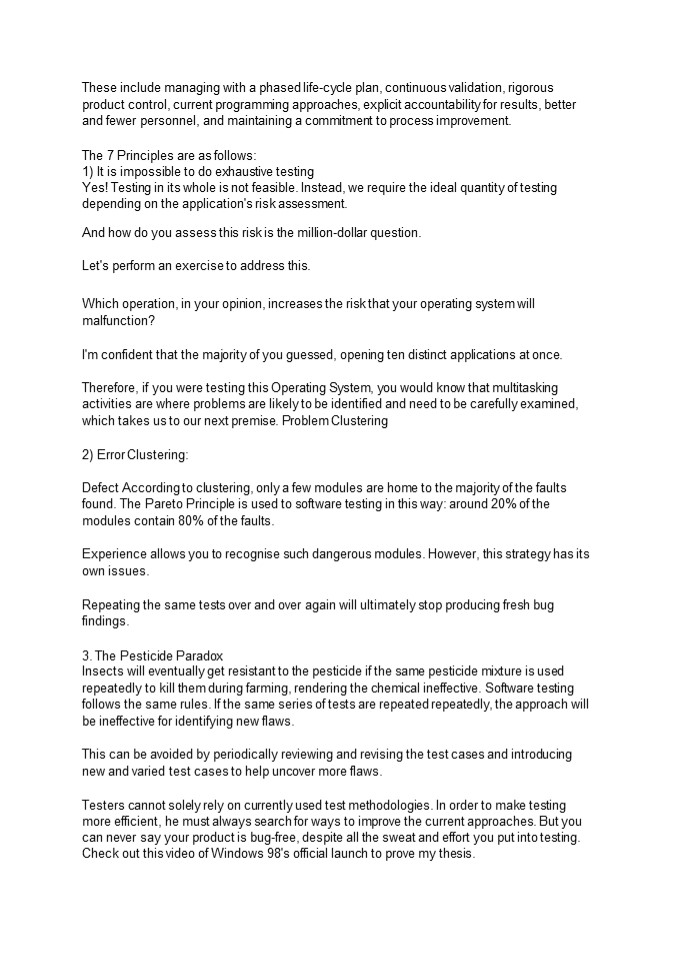SOftware Principles - PowerPoint PPT Presentation
Title:
SOftware Principles
Description:
The advantages of a properly implemented software development process include on-time sprints, a shorter time to market, stronger business foundations, improved IT procedures, and more benefits. E-mail:enquiry@login360.in Contact:+91-6385872810 #software #technology #programming #tech #coding #developer #business #softwaredeveloper #programmer #javascript #python #java #computer #html #hardware #webdevelopment #tecnologia #code #webdeveloper #softwareengineer #erp #webdesign #computerscience #o #coder #css #development #softwaredevelopment #android #it – PowerPoint PPT presentation
Number of Views:0
Title: SOftware Principles
1
- These include managing with a phased life-cycle
plan, continuous validation, rigorous product
control, current programming approaches, explicit
accountability for results, better and fewer
personnel, and maintaining a commitment to
process improvement. - The 7 Principles are as follows
- It is impossible to do exhaustive testing
- Yes! Testing in its whole is not feasible.
Instead, we require the ideal quantity of testing
depending on the application's risk assessment. - And how do you assess this risk is the
million-dollar question. Let's perform an
exercise to address this. - Which operation, in your opinion, increases the
risk that your operating system will
malfunction? - I'm confident that the majority of you guessed,
opening ten distinct applications at once. - Therefore, if you were testing this Operating
System, you would know that multitasking
activities are where problems are likely to be
identified and need to be carefully examined,
which takes us to our next premise. Problem
Clustering - Error Clustering
- Defect According to clustering, only a few
modules are home to the majority of the faults
found. The Pareto Principle is used to software
testing in this way around 20 of the modules
contain 80 of the faults. - Experience allows you to recognise such dangerous
modules. However, this strategy has its own
issues.
2
- Do you really believe a firm the size of
Microsoft wouldn't have adequately tested their
operating system and would risk their image
simply to see it fail during a public launch? - Testing reveals that there are flaws.
- Therefore, the testing principle asserts that
speaks only about the presence of flaws and not
about their absence. Software testing, for
example, lowers the likelihood that unknown flaws
will still be present in the software, but even
the absence of flaws is not evidence of
accuracy. - But what if you put in extra effort, take all
necessary safety measures, and produce software
that is 99 bug-free? Additionally, the software
does not satisfy the clients' demands
requirements. - This brings us to our final principle, which is
that error must not exist. - The fallacy of absence of error
- Software that is 99 bug-free might nevertheless
not work properly. This may occur if the system
is rigorously evaluated for the incorrect
requirement. Software testing involves more than
just looking for flaws.the needs of the business
are met by that software. Finding and repairing
errors will not help if the system build is
inoperable and fails to meet the demands and
requirements of the user. This is known as the
fallacy of the absence of error. - The following testing concept states that Early
Testing will help to address this issue. - Initial Testing
- Early testing - Early in the software development
life cycle, testing should begin. in order to
catch any flaws early on in the requirements or
design phases. Early in the testing process, a
Defect may usually be fixed for significantly
less money. But at what point should testing
begin? It is advised that you begin looking for
the bug as soon as the prerequisites are
established. More on this idea in a subsequent
training - Testing is reliant on context
- Testing is context-dependent, which essentially
means that you should test an e-commerce site
differently than you would a ready-made
commercial programme. The developed software is
not all the same. Depending on the type of
application, you could employ a different
strategy, methodology, technique, and type of
testing. Testing a POS system at a retail
location, for example, will differ from testing
an ATM.
3
(No Transcript)































